Fruits are one of the blessings of nature. Eating fruits is important and beneficial for our health. Our planet is full of fruits of different kinds, colors, and tastes. Every fruit has its importance and nutritive value giving specific benefits to the body. Apple is a common fruit with a sweet taste frequently discussed in different forms of art and literature in Europe. It is widely used in different recipes including salads, desserts, and eaten raw. Malus Domestica or apples are the most commonly cultivated species of the genus Malus. The wild ancestors of apples, Malus sieversii are still found in the Asian Region. Apple Garden is beautiful and beneficial yielding a huge quantity of fruit.
Apple Garden
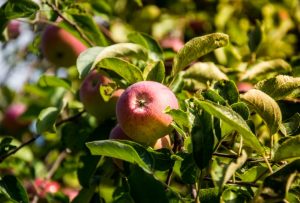
“An apple a day keeps the doctor away” is a famous saying not unknown to anyone. Often called “miracle food” and “nutritional powerhouse” apples are a good source of fiber and Vitamin C. These are rich in antioxidants polyphenols that have specific good effects on health. They are known to be beneficial for asthma, Alzheimer’s disease, Type 2 Diabetes, weight management, gastrointestinal and cardiovascular issues. From the concept of forbidden fruit to the Trojan War, the Norse gods, and the magical Apple of Samarkand in Arabian Nights, the apple garden has its specific importance in history.
The Beautiful Apple Garden
Green heavy trees with round beautiful colored fruits look pretty and fresh. The different varieties of fruit in different colors like red, light green, and yellow in the beautiful apple garden are surely a treat for the eyes.
Types of Apple Trees
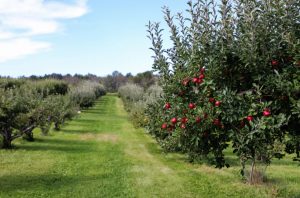
Types of Apple Trees According to Size
Apple has a wide range of types of fruit. However, according to the type and structure of the tree, there are two basic types;
- Dwarf Type.
- Tall Type.
The dwarf apple trees reach up to a height of about 4 to 8 feet. These are easier to cultivate and require lesser space and provide more varieties. However, the fruit size is smaller as compared to the fruit of tall apple trees. They have their cons like weak roots and vulnerable tree structures. They can get affected by heavier fruit yields as well.
The taller ones reach higher to the height of 20 to 30 feet. They are difficult t harvest and need more space. Fruit Plucking also gets comparatively different. However, the gardens of these trees are stronger and not get destroyed by climate factors like wind and full fruit growth.
Types of Apple Trees According to Growth Zone
The apple garden by growth zone can be divided into under mentioned types:
- Hardy Types.
- Long Season Types.
The hardy type of trees is adaptable in Hardiness Zones 3 to 5. On the other hand, long seasoned types of apple are best in Zones 5 to 8. You can check your Zone before selecting the type of trees to be cultivated in the apple garden.
Varieties of Apple Fruit
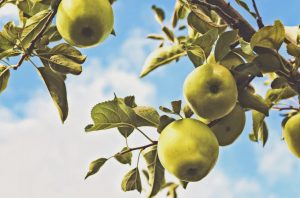
You will be surprised to know that nearly 2500 varieties of apple fruits are cultivated in the USA while commercial cultivators prefer around 100 varieties for the apple fruit garden. The number of varieties of this fruit cultivated worldwide is above 7000. Surprised? Aren’t you?
However, the varieties have been selectively cultivated over the years to produce the desired size, color, and taste. By the end of the 18th century, there were around 700 varieties of apple while in recent years 50 varieties are most preferred based on their qualities. Every variety was introduced in a specific year in the USA from its native land. The apple garden by the type of apples it produces can be classified accordingly. Here we are mentioning some of the popular yields of apples obtained from the apple gardens in the USA along with their basic characteristics.
Red Delicious:
Big heart-shaped; bright red, crispy, and mildly sweet.
Gala:
Gala is red with yellow patches, aromatic and sweet.
Fuji:
The fruit is yellowish-green with red shades, very sweet.
Granny Smith:
Big Green Fruit, crunchy and tart in taste.
Honey Crisp:
This is big bright fruit with strips of yellowish-green color, Juicy and sweet in color.
Cripps Pink:
This variety is bright pink in color, firm, sweet, and tart in taste.
Golden Delicious:
This is golden in color, sweet and mellow in taste. The flesh of the fruit does not change its color for longer periods as compared to other varieties.
There are many other famous varieties of apples that are specifically cultivated by typical cultivators in the USA. Some are mentioned below:
Ambrosia:
Medium to large-sized, Red base with yellow patches, sweet and crispy variety.
Ashmead Kernal:
Small heirloom apple, yellowish in color, very sweet.
Jonagold Apples:
The big bright red variety of apples.
Baldwin:
Good quality, large apple, bright red in color, taste mildly sweet.
Other varieties include Autumn Glory, Braeburn, Breeze, Cameo, Cosmic Crisp, Envy, Jazz, Juicy, Kanzi, Lady Alice, Pinata, Smitten, Sonya, and Sweetie.
Some disease-resistant varieties selected by organic growers are Jonna Free, Mac Free, Williams Pride, Prima, Priscila, Liberty, and Freedom. They can be grown without chemical sprays.
Ice Apples Al’s Garden

Ice apples are Fuji apples. The cultivators do not pick the fruits in the season until the frosting season. The flesh of the apples gets crystallized. This makes the apples extremely sweet and crispy. This is a famous form of Apples.
The apples need to be at a lower temperature of below 40 degrees Fahrenheit for at least days. After that, they need to be plucked immediately.
The high sugar content in ice apples makes them unsuitable for the markets because they can not be stored easily. Another drawback is that the harvesting time is not fixed as the cultivator has to wait for the frosting season for the apples to be “iced”. If the picking gets late or the temperature gets unsuitable, the whole lot of the fruit gets destroyed.
“Al’s” is a kind of a trademark for the ice apples. The farm has different branches and our producing fruits since 1948. The ice apples of Al’s garden are truly a treat to eat and are pretty famous in that region.
Requirements For Apple Trees in The Apple Fruit Garden
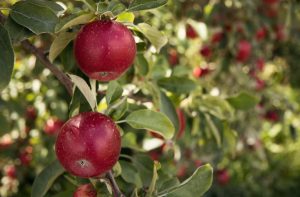
There are different varieties of apples each has its planting season and requirements.
Planting Seasons:
Planting in Central and Northern areas is better in March and April. In the regions where the air is mild and humid, you can start planting in the months of fall as well.
Planting Zones:
Do not forget to check the zone of the area you are selecting for the Apple Garden and select the tree type accordingly.
Chilling hours Requirements:
The seeds need to be chilled at a temperature between 32 to 45 degrees Fahrenheit. The cooler regions need longer hours of chilling to avoid future growth issues. This information can be achieved by a professional gardener or your local nursery.
Fertilizer Requirements:
The nutrient profile of the soil can be checked with the help of the Cooperative Extension Services of your area in this regard. The result of the tests will give a profile of the soil. After the soil report, you can discuss with the local nursery about the additions and fertilizer requirements for the soil. Please make sure that you add these extra nutritive products deeper into the oil up to 10 to 12 inches and not just the upper layer.
Sun Light Requirement:
The Apple trees need full sun exposure for their proper growth. So do not forget to consider if the area gets 6 to 7 hours of direct sunlight for the Apple Garden.
Soil Requirements:
Trees in The Apple Fruit Garden need well-drained soil. Too much wetness in the soil can cause issues in growth.
Mulching Requirements:
Mulching is required for good growth in the Apple Garden. This allows maximum distribution of nutrients and enhances the decomposition of the leaves and other organic material.
Spacing Requirements:
You need to consider the undermentioned factors for estimating the spacing between the trees.
- Rootstock
- Pruning
- Soil Fertility.
There should be a minimum distance of 15 to 18 feet between two trees in the arrow. A rootstock when dwarfed should be at a distance of at least 4 to 8 feet in a raw.
Site Requirements:
A higher site with a slope should be selected for the Apple Garden to let the cold air flow away from the apple trees without any disturbance to the branches or the fruits. Apple Garden should not be in the vicinity of wooded areas.
Steps For Cultivation in Apple Garden
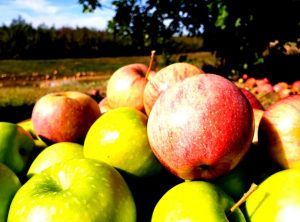
Tree Care before planting:
Keep the roots of the trees watered enough to avoid any drying out. The branches should be protected to avoid any damage. You can soak the roots in water for 24 hours before planting.
Soil Preparations:
The soil needs to be prepared before planting. The profile report should be obtained, as already explained above. You need to do the usual de-weeding and cleaning process which is done before planting any kind of seed.
Planting Process:
The hole should be at least twice the diameter of the roots expansion and the depth should be 2 feet. Allow the roots to penetrate deep down easily. Loosen the soil on the walls of the hole and put some of the loose soil back on the hole. Spread the roots in the hole while avoiding any damage to the roots. Cover the roots with the soil and remove any space between the walls and the roots to prevent drying.
Fertilizer Addition:
- In the spring season, once the apple garden starts yielding the fruit, you need to add a good nitrogen fertilizer because apples use nitrogen in a good amount once the fruit production starts. Fertilizers are not added in the hot months of July as it will disturb the growth process in the further yield. It is important to add the fertilizer in the drip line which is the region of dense, soft, and white roots that feed the nutrients to the plant.
- Experts advise adding some compost around the drip line every year in the spring season apart from the nitrogen fertilizer addition.
Care of The Apple Garden
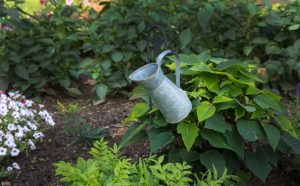
The Beautiful apple garden needs specific care like any other plant. The main aspects are discussed below;
Watering Requirement:
The young trees need regular watering to ensure the proper root formation.
Mulch Requirements:
Mulch should be renewed monthly. In the fall season, mulching should be removed to be safe from rodent attacks.
Framing the trees:
The trees are given a proper shape by framing the branches. This is especially for dwarf varieties to save them from collapsing due to the weight of the fruit.
Pruning:
Pruning in Young Trees:
The young trees can be pruned by different methods like;
- Rubbing misplaced buds before they turn into misplaced branches.
- Bending and roping the specific branches in the horizontal direction to slow down the growth and enhance branch formation and fruit growth.
Young trees are not pruned as it suppresses the growth. The dead and unhealthy branches are removed and shaping is done by the methods mentioned above.
Pruning in Mature Trees:
Mature trees in the apple gardens are pruned annually to maximize light and air which minimizes diseases. This ensures a healthy garden. Trees are pruned in their dormant state.
Thinning Apples:
Removing some apples from the apple trees to reduce the burden on the tree and provide space is called thinning. This enhances the quality and quantity of the current and the next yield of the trees.
After about 4 to 6 weeks of full bloom of the apple trees, the natural fruit drop takes place. In this stage, experts advise removing at least one apple from each cluster.
Protection from Diseases:
The apple gardens are prone to pests like maggots, fruit worms, codling moths, and curculios.
Expert Cultivators advise a suitable pesticide spray in the garden once a year to save the trees from pests and diseases.
Anti Insect Oils and organic medicines can also be used to avoid such diseases however they are not as effective as strong chemical pesticides.
There are other methods to control pests like the hanging ball method for maggots and Natural parasites and predator populations.
Rodents and deer are avoided by fencing and meshing.
Apple Picking Garden Near Me
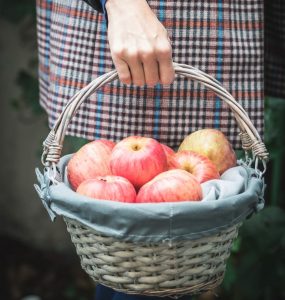
In New York City there are at least 12 famous places for apple picking. These places have lots of festivity like picking of other fruit and vegetables like maze and pumpkins. Food and live music are also a part of the entertainment package in the famous apple picking gardens near me. These apple picking gardens charge a specific entry ticket and other internal charges from people who come to enjoy the place.
- Harvest Moon Farm is a famous Farm and Orchard in North Salem. This Apple Garden hosts a festival in the fall of every season. This festival is full of enjoyment and fun with different kinds of local games, fruit picking, fancy foods, and musicians creating live music.
- Lawrence Farms in New burgh has been hosting fruit pickers for almost the last 3 decades. There is a variety of entertainment sources and a “little Village”. In this artificially created farmhouse of village setup, people go to enjoy the lifestyle of villages.
- Other famous apple picking gardens in New York includes Apple Dave’s Orchard and Masker Orchard in Warwick, Barton Orchards in Poughqaug, and DuBois Farms in Highland. These apple picking gardens offer different kinds of enjoyments and recreational activities. Other cities also have such Apple Gardens in which people come with their families and spend some healthy and quality time together in a natural environment.
Ideal Time To Go To Apple Picking Farm Near Me
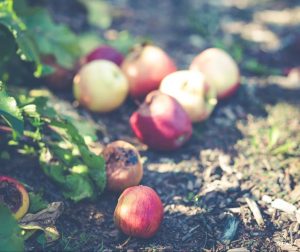
Different varieties of apples get ripen in different seasons. In the USA and Canada, common seasons of yielding in the apple gardens are after the mid of September up till the mid of October.
Related Posts:
Conclusion
Apple is a delicious and nutritive fruit. It has many different varieties. The apple gardens can also be divided into different types according to their growth zones and their heights. The cultivators need to follow certain steps of care to maintain a healthy apple garden and get good yields of this fruit.

